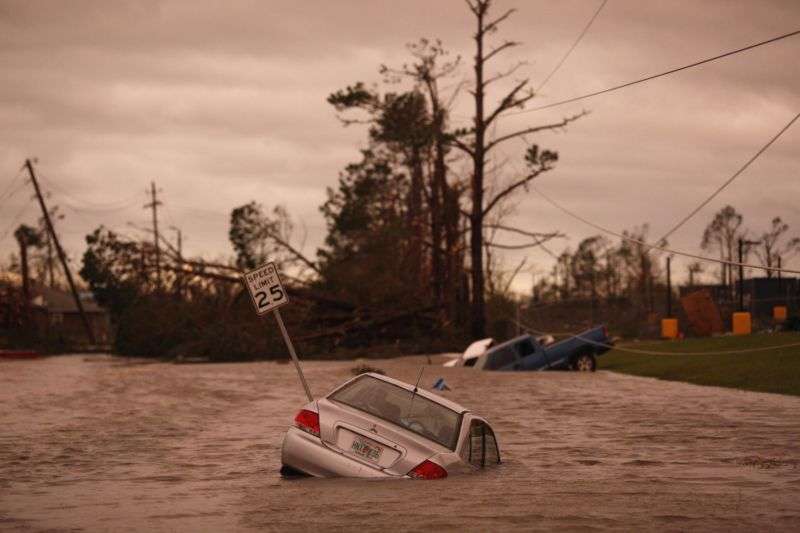
Verizon fiber suffered “unprecedented” damage from Hurricane Michael

Nearly 300,000 households were still without home Internet, phone, or TV service yesterday in Florida, Georgia, and Alabama, as telcos scramble to repair networks damaged by Hurricane Michael. More than 200,000 of the households without cable or wireline service are in Florida, according to the Federal Communications Commission.
Mobile service has also taken a big hit, with outages affecting about 15 percent of cell sites in the 21 Florida counties where the FCC is tracking hurricane-related outages.
Carriers have made progress in reducing those outage numbers the past few days. Nearly 29 percent of tracked cell sites in Florida were out as of October 11, but the outage rate has been nearly cut in half since.
“Unprecedented” fiber damage
Still, carrier efforts to restore mobile service have been hampered by extensive fiber damage.
“The storm caused unprecedented damage to our fiber, which is essential for our network—including many of our temporary portable assets—to work,” Verizon said yesterday on its webpage for hurricane updates.
Verizon said today that its fiber is still suffering new damage from other restoration efforts:
We continue to work round the clock on network restoration efforts and have seen some positive movement, although fiber connection—needed for cell sites and some mobile assets to work—still poses a significant challenge. For example, as soon as we have fiber repaired and start to see sites come back on air, we experience new cuts resulting from other restoration efforts happening in the community such as clearing roads, residential property clearing, and replacing electric poles.
Verizon said today that “99 percent of our network is in service in Georgia and 98 percent in Florida,” but those numbers appear to be for the entire state instead of just the disaster zones tracked by the FCC. “[T]he hardest hit area of Panama City, Panama City Beach and the surrounding communities [are] still experiencing the most impact,” Verizon said.
Verizon has both underground fiber and fiber hung from poles in the affected areas, according to The Wall Street Journal.
AT&T said today that its “network is performing well and nearly fully restored in most affected areas.” AT&T is using portable cell sites “in numerous locations throughout Florida and Georgia” while the carrier repairs its network.
FCC disaster reporting
The FCC activated its disaster information reporting system on October 9 and has provided daily outage updates since the Category 4 hurricane made landfall on October 10. The latest update, released yesterday, shows that carriers have a way to go in restoring service for both mobile networks and wired connections to people’s homes.
More than 66 percent of the cell sites (216 out of 327) in Florida’s Bay County were out, while more than 69 percent of cell sites (16 out of 23) in Florida’s Gulf County were out. Across the 21 Florida counties that are part of the FCC’s disaster reporting, 383 out of 2,543 (15.1 percent) of cell sites were out of service.
In Georgia, 2 percent of cell sites in tracked areas were out yesterday, down from 14.2 percent on October 11. The outage rate yesterday was 50 percent in Georgia’s Early County and more than 18 percent in Decatur County. In Alabama, 1.1 percent of cell sites in tracked areas (8 out of 759) were out yesterday, down from 9.2 percent on October 11.
While the number of cell site outages provides a rough approximation of the storm’s impact, the FCC said the statistic “does not necessarily correspond to the availability of wireless service to consumers in that area.”
“Wireless networks are often designed with numerous, overlapping cell sites that provide maximum capacity and continuity of service even when an individual site is inoperable,” the FCC said. Carriers also “frequently use temporary facilities such as cells-on-wheels” to keep service up in disaster areas.
Charter cable customers still lack service
Most of the home Internet outages are in Florida, where 205,643 cable or wireline subscribers remained out of service yesterday. The cable and wireline outages affect Internet, phone, and TV service. The Florida wireline outages were at their peak on October 12, when 252,748 households were affected. Many of the outages affect Charter Spectrum customers.
“Our technicians are working to restore Spectrum service interrupted by damage from Michael,” Charter said. “Power outages continue to affect many of our customers, and electricity is necessary before we can restore or troubleshoot Spectrum service. Restoration will be ongoing as conditions permit.”
Nearly 70,000 Georgia households were still without cable or wireline service yesterday, down from 103,775 on October 11. Nearly 16,000 Alabama households were still without service yesterday, down from 18,244 on October 11.
Disclosure: The Advance/Newhouse Partnership, which owns 13 percent of Charter, is part of Advance Publications. Advance Publications owns Condé Nast, which owns Ars Technica.




